Being a roofing contractor was a seasonal job and obviously not a long-term goal. One year, while he was off work from construction during a particularly cold and snowy Calgary winter, Jerry did a little painting. He notes, “That is when I met Doug Swinton, owner of Swinton’s Art Supply & Instruction. I went into the art store for supplies and came out with a job. Working there got me excited about painting again and I started to think that maybe doing this for a living could be possible. My wife Leah was working full time, and we had managed to pay off her student loans, so I thought it might be time to take another crack at this “being an artist” thing.”
Doug Swinton introduced Jerry and Leah to Jean and Dean Geddes – Jean is also a professional artist from Calgary. Jerry says, “Jean and Dean taught us about the business of being an artist. We learned how to price paintings, approach galleries, form relationships with collectors, and so much more. Jean was also my painting teacher. She taught me how to paint what I see. In fact, Jean taught me to ‘see’ for the first time, which was a huge moment in my painting process. She also taught me about mixing and applying paint, but the biggest thing she taught me was to take painting seriously; if I wanted to make it my job I had better treat it as a job. This is when I started painting eight hours a day, whether I liked it or not.” The journey then began in earnest.
Struggling Through To Success
Then came the hardest five years of Jerry’s life. A time filled with self-doubt, little success and a lot of painting. There were painting trips and excursions to the mountains, time spent in contemplation, and the continuing support of Doug Swinton.
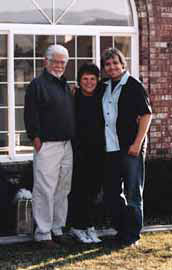 “Doug and I decided to go on a road trip to see artists Bill Reese and Clyde Aspevig in the United States,” says Jerry. “Meeting Bill and his wife Fran changed the trajectory of my painting journey again. They had done it – they were the first people I had met that had made a life and supported a family by creating pictures. They were also very welcoming and happy to show us their collection, including paintings by Matt Smith, Ramon Kelly, Richard Schmid, Sergei Bongart, Bob Kuhn, Edgar Payne and many others. It was awe inspiring. We ended up staying for dinner and meeting again the next day, which was the beginning of a mind-expanding relationship. It was the freedom that really appealed to me; being able to carve out one’s own lifestyle, even though I knew it wouldn’t be easy.”
“Doug and I decided to go on a road trip to see artists Bill Reese and Clyde Aspevig in the United States,” says Jerry. “Meeting Bill and his wife Fran changed the trajectory of my painting journey again. They had done it – they were the first people I had met that had made a life and supported a family by creating pictures. They were also very welcoming and happy to show us their collection, including paintings by Matt Smith, Ramon Kelly, Richard Schmid, Sergei Bongart, Bob Kuhn, Edgar Payne and many others. It was awe inspiring. We ended up staying for dinner and meeting again the next day, which was the beginning of a mind-expanding relationship. It was the freedom that really appealed to me; being able to carve out one’s own lifestyle, even though I knew it wouldn’t be easy.”
Jerry returned home with renewed vigor to create the lifestyle he wanted as an artist. He continued to paint and did some teaching from a converted garage, while Leah started an online marketing company working from home.
Seeing It Through
 Today Jerry’s studio is separate from the house, in a quiet rural neighborhood overlooking Lake Okanagan in BC; the kind of place that allows him to get into the right frame of mind without many outside influences. Except for the deer, bear and other wildlife that wander by on occasion. The studio has a scenic view in all four seasons, close to the mountains, and inside it is filled with paintings by other artists.
Today Jerry’s studio is separate from the house, in a quiet rural neighborhood overlooking Lake Okanagan in BC; the kind of place that allows him to get into the right frame of mind without many outside influences. Except for the deer, bear and other wildlife that wander by on occasion. The studio has a scenic view in all four seasons, close to the mountains, and inside it is filled with paintings by other artists.
 “There are a lot of painting props in the studio, such as pots, fabrics, jars and whats-its,” says Jerry, “as well as art books, vintage goalie equipment, sculptures, and photos of family and friends. I guess the most special thing I have in there is my Grandfather’s chair and a sweater he wore whenever we did woodworking together in his shop. It reminds me of his integrity and the hard worker he was, and that inspires me to be better.”
“There are a lot of painting props in the studio, such as pots, fabrics, jars and whats-its,” says Jerry, “as well as art books, vintage goalie equipment, sculptures, and photos of family and friends. I guess the most special thing I have in there is my Grandfather’s chair and a sweater he wore whenever we did woodworking together in his shop. It reminds me of his integrity and the hard worker he was, and that inspires me to be better.”
His Process
 “My process is dependent upon inspiration and the desired result for the painting,” says Jerry, “meaning the process itself changes based on what I want to say and how I want to say it with each piece. Painting from life or outdoors may require a faster, more direct approach with little or no pre-planning or preconceived ideas. Other times, I have an idea in my mind which requires hiring models, or traveling to a specific location, or taking photos to develop the idea. Sometimes the inspiration is a color, an application of paint, or making marks, and the subject becomes secondary. As for the painting process, in general it is fat over lean – starting with thin paint and building it up to thicker paint at the end; trying to balance form and content that is aesthetically pleasing, yet creative.”
“My process is dependent upon inspiration and the desired result for the painting,” says Jerry, “meaning the process itself changes based on what I want to say and how I want to say it with each piece. Painting from life or outdoors may require a faster, more direct approach with little or no pre-planning or preconceived ideas. Other times, I have an idea in my mind which requires hiring models, or traveling to a specific location, or taking photos to develop the idea. Sometimes the inspiration is a color, an application of paint, or making marks, and the subject becomes secondary. As for the painting process, in general it is fat over lean – starting with thin paint and building it up to thicker paint at the end; trying to balance form and content that is aesthetically pleasing, yet creative.”
The content tends to be as varied and interesting as the man, himself. It truly is whatever captures his interest and artistic eye. Jerry says he likes to continually push himself and the work, experimenting with compositions and lighting, and the way paint is applied. He explains, “I like to start out quite loose and somewhat abstract, allowing the picture to evolve in front of me. Trying not to get too bossy with the paint; allowing it room to move while pulling out the form of the whole. I feel this helps keeps the painting from getting too tight or content driven. For me, a looser painting allows the viewer to access it through their own filter, rather than dictate to them what to see. I have found paintings like this more interesting to view, so I try to paint that way. It is a challenge to keep it loose, yet keep the drawing accurate without getting too tight with the process, but I am learning. It is the struggle to balance form and content.”
Although he is reticent to directly define his style, preferring to leave that for others to decide, Jerry admits that his wife would say he is defined by a determination that borders on obsession. He adds, “Often, a problem I am trying to overcome within my work will inspire a lot of paintings, as I try to get better at that specific part. The journey to the perfect picture, which I know does not exist, is what inspires me to paint again and again. The subject or content is often not the inspiration, it is the form of a thing, and how to depict it in a picture that is creative and aesthetically pleasing.”
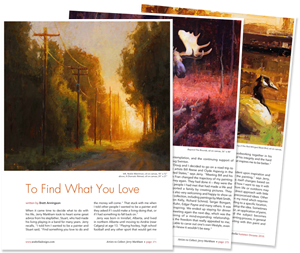 Jerry was recently interviewed by Arabella Magazine. You can read the full article here and see additional questions below from the interview.
Jerry was recently interviewed by Arabella Magazine. You can read the full article here and see additional questions below from the interview.






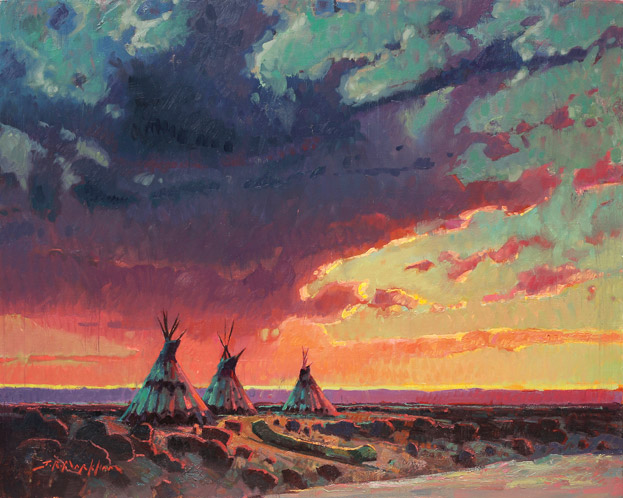
 “Doug and I decided to go on a road trip to see artists Bill Reese and Clyde Aspevig in the United States,” says Jerry. “Meeting Bill and his wife Fran changed the trajectory of my painting journey again. They had done it – they were the first people I had met that had made a life and supported a family by creating pictures. They were also very welcoming and happy to show us their collection, including paintings by Matt Smith, Ramon Kelly, Richard Schmid, Sergei Bongart, Bob Kuhn, Edgar Payne and many others. It was awe inspiring. We ended up staying for dinner and meeting again the next day, which was the beginning of a mind-expanding relationship. It was the freedom that really appealed to me; being able to carve out one’s own lifestyle, even though I knew it wouldn’t be easy.”
“Doug and I decided to go on a road trip to see artists Bill Reese and Clyde Aspevig in the United States,” says Jerry. “Meeting Bill and his wife Fran changed the trajectory of my painting journey again. They had done it – they were the first people I had met that had made a life and supported a family by creating pictures. They were also very welcoming and happy to show us their collection, including paintings by Matt Smith, Ramon Kelly, Richard Schmid, Sergei Bongart, Bob Kuhn, Edgar Payne and many others. It was awe inspiring. We ended up staying for dinner and meeting again the next day, which was the beginning of a mind-expanding relationship. It was the freedom that really appealed to me; being able to carve out one’s own lifestyle, even though I knew it wouldn’t be easy.” Today Jerry’s studio is separate from the house, in a quiet rural neighborhood overlooking Lake Okanagan in BC; the kind of place that allows him to get into the right frame of mind without many outside influences. Except for the deer, bear and other wildlife that wander by on occasion. The studio has a scenic view in all four seasons, close to the mountains, and inside it is filled with paintings by other artists.
Today Jerry’s studio is separate from the house, in a quiet rural neighborhood overlooking Lake Okanagan in BC; the kind of place that allows him to get into the right frame of mind without many outside influences. Except for the deer, bear and other wildlife that wander by on occasion. The studio has a scenic view in all four seasons, close to the mountains, and inside it is filled with paintings by other artists. “There are a lot of painting props in the studio, such as pots, fabrics, jars and whats-its,” says Jerry, “as well as art books, vintage goalie equipment, sculptures, and photos of family and friends. I guess the most special thing I have in there is my Grandfather’s chair and a sweater he wore whenever we did woodworking together in his shop. It reminds me of his integrity and the hard worker he was, and that inspires me to be better.”
“There are a lot of painting props in the studio, such as pots, fabrics, jars and whats-its,” says Jerry, “as well as art books, vintage goalie equipment, sculptures, and photos of family and friends. I guess the most special thing I have in there is my Grandfather’s chair and a sweater he wore whenever we did woodworking together in his shop. It reminds me of his integrity and the hard worker he was, and that inspires me to be better.” “My process is dependent upon inspiration and the desired result for the painting,” says Jerry, “meaning the process itself changes based on what I want to say and how I want to say it with each piece. Painting from life or outdoors may require a faster, more direct approach with little or no pre-planning or preconceived ideas. Other times, I have an idea in my mind which requires hiring models, or traveling to a specific location, or taking photos to develop the idea. Sometimes the inspiration is a color, an application of paint, or making marks, and the subject becomes secondary. As for the painting process, in general it is fat over lean – starting with thin paint and building it up to thicker paint at the end; trying to balance form and content that is aesthetically pleasing, yet creative.”
“My process is dependent upon inspiration and the desired result for the painting,” says Jerry, “meaning the process itself changes based on what I want to say and how I want to say it with each piece. Painting from life or outdoors may require a faster, more direct approach with little or no pre-planning or preconceived ideas. Other times, I have an idea in my mind which requires hiring models, or traveling to a specific location, or taking photos to develop the idea. Sometimes the inspiration is a color, an application of paint, or making marks, and the subject becomes secondary. As for the painting process, in general it is fat over lean – starting with thin paint and building it up to thicker paint at the end; trying to balance form and content that is aesthetically pleasing, yet creative.” Though neither of my parents are artistically inclined, they both worked extremely hard and I think my work ethic must have come from them.
Though neither of my parents are artistically inclined, they both worked extremely hard and I think my work ethic must have come from them.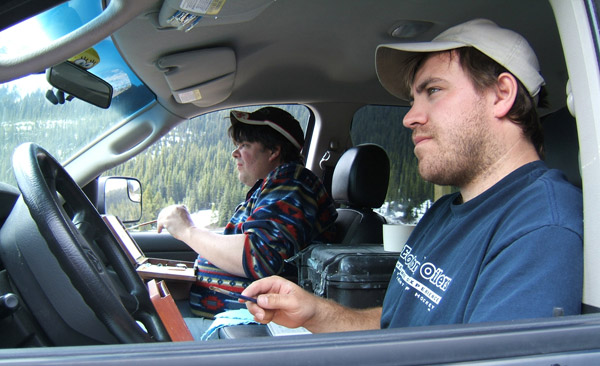
 Doug introduced Leah and I to Jean and Dean Geddes – Jean is also a professional artist from Calgary. They taught us about the business side of being an artist and Jean was also my painting teacher. She taught me how to ‘paint what I see’. But the biggest thing was to take painting seriously – if I wanted to make it my job I had better treat it as a job. So I started painting at least 8 hours a day. At that point I still had another job working at a hardware store evenings and weekends and didn’t yet make money through painting, but Jean and Dean encouraged me to keep it up. Dean would say “Keep your pecker up” – I learned that meant to keep your chin up.
Doug introduced Leah and I to Jean and Dean Geddes – Jean is also a professional artist from Calgary. They taught us about the business side of being an artist and Jean was also my painting teacher. She taught me how to ‘paint what I see’. But the biggest thing was to take painting seriously – if I wanted to make it my job I had better treat it as a job. So I started painting at least 8 hours a day. At that point I still had another job working at a hardware store evenings and weekends and didn’t yet make money through painting, but Jean and Dean encouraged me to keep it up. Dean would say “Keep your pecker up” – I learned that meant to keep your chin up. Bill Reese and his wife Fran showed Leah and I it was possible to have a successful living as an artist. Bill had been a full-time painter and supported his family doing it. He also fully embraced life and continued learning and growing until he passed away in June 2010. He played music in a band, painted, sculpted, carved leather, wrote a book, and did all kinds of things. It was encouraging to us even though they were honest about the difficulty of the art journey as well. Bill taught me to think and ask ‘why’ a lot. He was interested in why I painted paintings. This was not something I thought too much about at that point. I had been so concerned with learning how to paint and always getting better at it, that I had not stopped to think about why I painted. He challenged me to go deeper about what I was doing – that if you know why, it will often tell you how. This has been a lesson I use in everything in life – slowing down and asking myself why, and to challenge conventional thinking.
Bill Reese and his wife Fran showed Leah and I it was possible to have a successful living as an artist. Bill had been a full-time painter and supported his family doing it. He also fully embraced life and continued learning and growing until he passed away in June 2010. He played music in a band, painted, sculpted, carved leather, wrote a book, and did all kinds of things. It was encouraging to us even though they were honest about the difficulty of the art journey as well. Bill taught me to think and ask ‘why’ a lot. He was interested in why I painted paintings. This was not something I thought too much about at that point. I had been so concerned with learning how to paint and always getting better at it, that I had not stopped to think about why I painted. He challenged me to go deeper about what I was doing – that if you know why, it will often tell you how. This has been a lesson I use in everything in life – slowing down and asking myself why, and to challenge conventional thinking.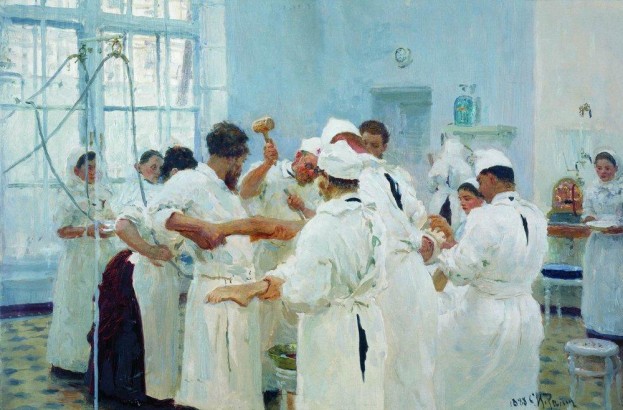 ‘The Surgeon E. Pavlov in the Operating Theatre’ by Ilya Repin
‘The Surgeon E. Pavlov in the Operating Theatre’ by Ilya Repin

